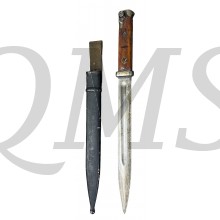The SVT-40 (Samozaryadnaya Vintovka Tokareva, Obrazets 1940 goda, "Tokarev self-loading rifle, model of 1940", Russian: Самозарядная винтовка Токарева, образец 1940 года, often nicknamed "Sveta") was a Soviet semi-automatic battle rifle. It was designed as a replacement for its predecessor, the SVT-38.
The SVT-40 saw widespread service during and after World War II. It was intended to be the Soviet Red Army's new service rifle, but its production was disrupted by the German invasion in 1941, resulting in a change back to the Mosin–Nagant rifle for the duration of World War II. After the war, the Soviet Union adopted new rifles, such as the SKS and the AK-47.
Much like other countries, a switch was made from the long bayonets of the WWI era to a shorter "knife" style bayonet. The bayonet developed for the SVT-40 was the first Russian knife bayonet, and its influence is evident in the later SKS and AK47 bayonets. The M1940 bayonet is unique in having a sheath surrounding the press stud to prevent the fixed bayonet from being inadvertently detached. This proved a solution to a non-existent problem and was dropped from future Russian designs.
